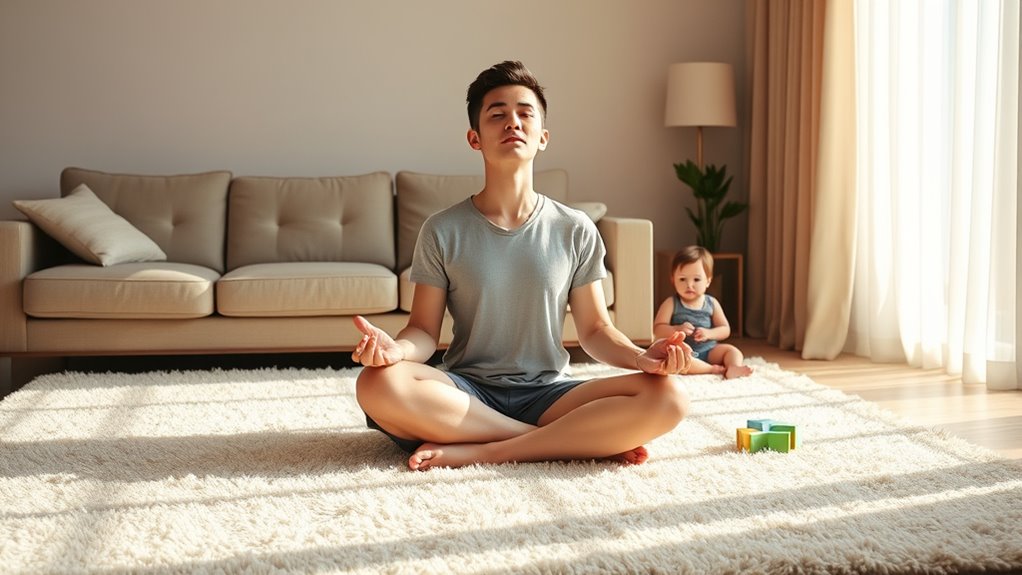As a busy parent, incorporating simple breathing techniques into your day can considerably reduce stress and help you stay calm. Focus on mindful breaths—deep inhales through your nose, hold briefly, then exhale slowly—to anchor yourself in the present moment. Use quick pauses during daily activities or after kids’ bedtime for this practice. Regularly practicing these techniques will improve your resilience and overall well-being, so keep going to learn more easy ways to stay centered amid chaos.
Key Takeaways
- Practice short, mindful breathing exercises during quick breaks to reduce stress instantly.
- Focus on slow, deep breaths through the nose to activate relaxation and calmness.
- Incorporate breathing routines into daily activities like waiting in line or after children’s bedtime.
- Use reminders or notes to encourage regular mindful breathing for long-term stress management.
- Recognize that even brief pauses for breathing can improve patience, clarity, and overall well-being.

As a busy parent, finding moments to relax can feel impossible amid endless to-do lists and constant demands. Your days are packed with caring for your kids, managing household chores, and trying to keep everything running smoothly. It’s no wonder stress can build up quickly. That’s why learning simple breathing techniques, like mindful breathing, can be a game-changer. These techniques are easy to incorporate into your busy schedule and can provide quick stress relief whenever you need it.
Mindful breathing is all about paying close attention to your breath. Instead of letting your mind wander or getting caught up in worries, you focus on each inhale and exhale. This practice helps anchor you in the present moment, making it easier to let go of anxiety and tension. You can do this anywhere—while waiting in line, during a quick break, or even while sitting at the dinner table. To get started, just take a deep breath in through your nose, filling your lungs completely. Hold that breath for a second, then slowly exhale through your mouth or nose. Repeat this process, paying close attention to the sensation of the air moving in and out. By doing this, you activate your parasympathetic nervous system, which promotes relaxation and reduces stress.
When stress feels overwhelming, mindful breathing offers immediate relief. It’s a simple tool to reset your mind and body, helping you approach situations with more patience and clarity. Over time, regular practice can improve your overall resilience to stress, making daily challenges feel more manageable. It also encourages a sense of calm that can positively affect your interactions with your children, making your responses more composed and nurturing.
You don’t need special equipment or a lot of time to benefit from mindful breathing. Just a few moments—perhaps during a nap or after putting the kids to bed—are enough to make a difference. You might find it helpful to set reminders on your phone or attach a note to your fridge to prompt you to pause and breathe deeply. Remember, the goal isn’t to escape your responsibilities but to equip yourself with a simple, effective tool to manage stress. As you practice regularly, these moments of mindful breathing become a natural part of your routine, giving you a quick mental reset whenever life gets hectic. Incorporating breathing techniques can also positively influence your sleep quality, helping you wake up feeling more refreshed and prepared. In the long run, embracing this practice can help you feel more centered, balanced, and better prepared to handle the busy days ahead.
Frequently Asked Questions
Can Breathing Techniques Replace Professional Mental Health Support?
Breathing techniques and mindfulness meditation can help with stress reduction, but they shouldn’t replace professional mental health support. These methods are great tools for managing daily stress and promoting relaxation, yet they don’t address underlying issues that may require expert guidance. If you’re feeling overwhelmed or persistent mental health concerns, it’s essential to seek professional help. Use breathing exercises as a complementary approach, not a substitute, for holistic care.
How Long Does It Take to See Benefits From Regular Practice?
You’ll notice immediate effects after just one practice session, but to truly experience lasting benefits, you need consistent practice. Usually, within a few weeks of daily breathing exercises, you’ll feel calmer and more centered. The key is practice consistency—it’s like watering a plant; the more you do it, the faster and stronger the growth. Stick with it, and you’ll see impressive results in no time!
Are There Any Risks or Contraindications for Specific Breathing Methods?
You should be aware that some breathing techniques carry dizziness risks if you hyperventilate or breathe too rapidly. If you have asthma, take precautions by consulting your doctor before trying certain methods, especially those involving deep or forceful breathing. Always listen to your body, and stop if you feel faint or uncomfortable. Starting slowly and gradually increasing intensity helps minimize risks, ensuring safe and effective practice.
Can Children or Teenagers Practice These Breathing Techniques?
An ounce of prevention is worth a pound of cure. Yes, children and teenagers can practice breathing techniques, but with guidance to guarantee safety. These methods can help with child relaxation and reduce teen anxiety. Keep sessions short, age-appropriate, and supervised to avert any discomfort. Always consult a healthcare professional if your child has underlying health issues or concerns before starting new breathing exercises.
What Is the Best Time of Day to Practice for Maximum Relaxation?
You should practice breathing techniques during morning mindfulness or evening relaxation for maximum benefits. Morning sessions help set a calm tone for your day, while evening practice eases stress and promotes restful sleep. Find a quiet moment when you’re undistracted, ideally before starting your day or winding down at night. Consistency is key, so choose a time that fits your schedule and make it a daily habit for lasting relaxation.
Conclusion
Taking a few deep breaths amidst your hectic day can instantly bring calm and clarity. These simple techniques fit seamlessly into your busy schedule, helping you stay centered and present for your family. Imagine yourself pausing, inhaling peace, and exhaling stress—how much easier would your day feel? Remember, you don’t need hours to recharge. Just a moment of mindful breathing can make a world of difference. Ready to breathe easier and feel more in control?









